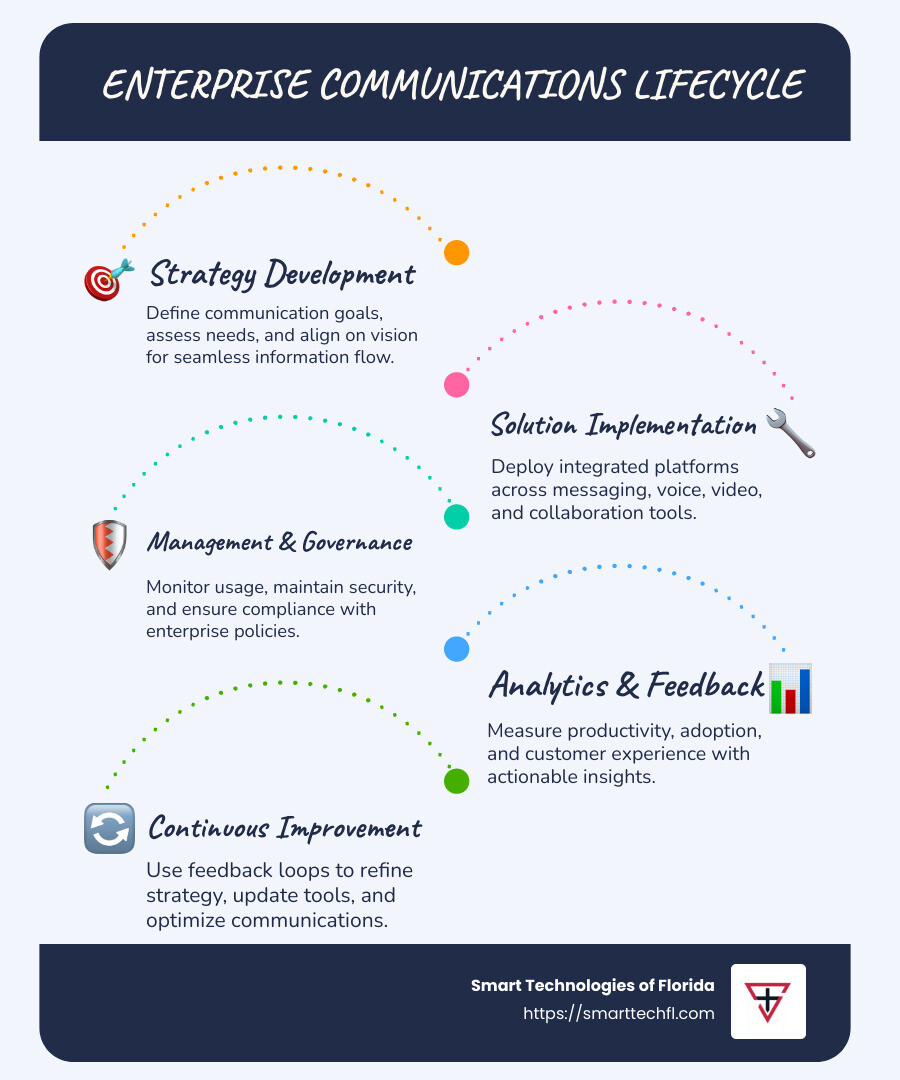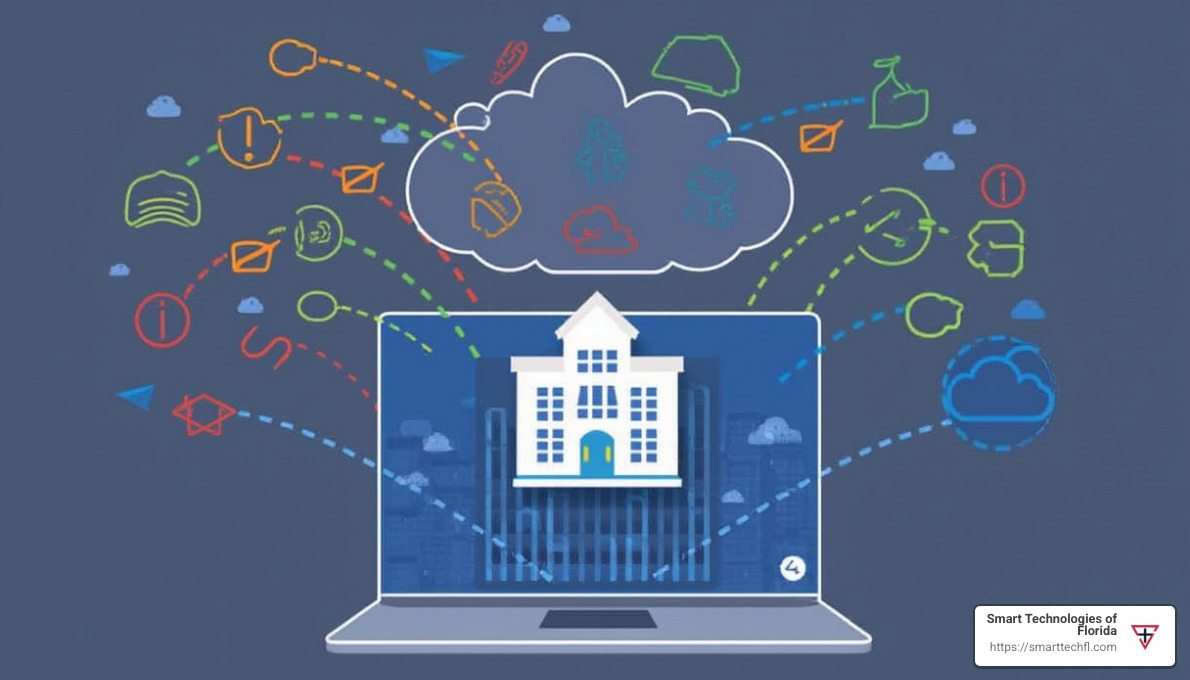Let’s Talk Enterprise Communications (No, Seriously!)
Enterprise communications isn’t just about phones and emails anymore. It’s a living, breathing ecosystem that connects every part of your business, both inside and out. Think of it as the invisible threads that weave your company together – keeping teams aligned, customers happy, and operations running smoothly.
At its core, enterprise communications encompasses all the ways information flows throughout your organization. It’s the difference between a business that moves with purpose and one that struggles with mixed messages and missed opportunities.
When we talk about internal communications, we’re referring to all the ways your team members connect with each other – from quick chats and video calls to collaborative documents and team meetings. Organizations with strong internal communication systems see a remarkable 20-25% boost in productivity. Why? Because when people know what’s happening and feel heard, they work better.
External communications, on the other hand, covers how you engage with customers and partners. Get this right, and you’ll see customer satisfaction jump by as much as 35%. In today’s world where everyone expects immediate, personalized responses, having streamlined external communication channels isn’t optional – it’s essential.
“The larger your organization becomes, the more critical communication is to success. Yet, it’s easy to overlook enterprise-grade tools and strategies to scale,” notes communications expert Chris Reaburn. This insight hits the nail on the head – as businesses grow, communication becomes more complex and more crucial simultaneously.
Here’s something that should grab your attention: 86% of employees believe ineffective communication is the primary cause of workplace failures. That’s not just a statistic – it’s a warning. When communication breaks down, everything else tends to follow.
For retail businesses specifically, solid enterprise communications creates a seamless bridge between physical stores and online channels. Your customers expect the same experience whether they’re shopping in-person or on their phone at midnight. The right communication systems make this consistency possible.
Think of enterprise communications as your company’s nervous system. When it works well, information flows effortlessly, decisions happen faster, and everyone – from your newest hire to your CEO to your customers – feels connected to what matters most.

Whether you’re running a single location or managing multiple sites, investing in the right enterprise communications strategy isn’t just about adopting new technology – it’s about changing how your entire business operates. It’s about making sure that when someone has something important to share, nothing stands in their way. And in today’s business environment, that kind of seamless connection isn’t just nice to have – it’s essential for survival and growth.
What Is Enterprise Communications & Why It Matters
Enterprise communications is so much more than just phones ringing and emails pinging. It’s the lifeblood of your organization—a complete ecosystem of systems, tools, and processes that keep information flowing smoothly both inside your company and with the outside world.
In today’s work-from-anywhere business landscape, having robust communication systems isn’t just nice to have—it’s essential. Companies with well-connected teams see a remarkable 20-25% boost in productivity. This makes perfect sense when you consider that 86% of workplace failures stem directly from communication breakdowns.
“Communication is one place where your company can’t afford to get left behind,” as enterprise communications specialist Josh Harder puts it. And he’s right—poor communication doesn’t just frustrate your team; it directly impacts your bottom line and customer satisfaction.

The pandemic fundamentally changed how we work together. According to the New York Times, 54% of Manhattan employers now operate fully remote models, with less than 10% requiring full-time office presence. This massive shift has transformed enterprise communications from a background utility into mission-critical infrastructure.
The impact goes beyond just keeping teams connected. Organizations using communications systems integrated with their CRM report a 29% increase in sales and 35% higher customer satisfaction. These aren’t just feel-good metrics—they translate directly to revenue growth.
Enterprise Communications as Your Corporate Nervous System
Think about how your own body works. Your nervous system sends signals constantly, helping all parts work together seamlessly. That’s exactly what good enterprise communications does for your organization.
Just like a healthy nervous system creates coordination, your communication infrastructure creates information symmetry—ensuring everyone has access to what they need, when they need it. According to research from McKinsey, companies with connected employees are 20-25% more productive because they waste less time hunting for information or waiting for responses.
When information flows freely, decisions happen faster. IDC research found that the average employee wastes 5.3 hours weekly just waiting for information or recreating data that already exists somewhere in the organization. Effective enterprise communications eliminates this waste.
Employee engagement flourishes when communication channels are open and accessible. Trade Press Services reports that 85% of employees feel most motivated when leadership provides regular updates on company news and developments. People want to be in the loop!
And perhaps most exciting: innovation thrives when ideas can cross-pollinate between departments and teams. The most innovative organizations have communication systems that break down silos and enable collaboration regardless of where people sit.
The ROI of Staying Connected
The return on investment for robust enterprise communications shows up in measurable ways across your business:
When teams are well-connected, they save nearly 100 minutes per week on average—time they can redirect to meaningful work instead of tracking down information. Sales teams equipped with integrated messaging systems respond to leads faster and engage with customers more effectively, driving that 29% sales increase mentioned earlier.
Customer satisfaction jumps by 35% when your communications systems enable seamless omnichannel support. And according to Gallup research, organizations with effective internal communications enjoy 4.5 times higher employee retention rates—a massive advantage in today’s competitive talent market.
Real-world success stories back this up. Crawford Technologies reported an impressive Net Promoter Score of +81 (considered world-class in any industry) and closed 2024 with 9% year-over-year revenue growth—their highest point in 29 years of business.
As Marty van de Veerdonk, Solution Consultant at a major service provider, explains: “We selected Oracle’s session border controllers because they are flexible, cost-efficient, and very secure. They enable us to connect to all different cloud communications solutions.” His experience highlights how the right infrastructure choices directly impact business performance.
In today’s hybrid work environment, enterprise communications isn’t just about keeping the lights on—it’s about creating the connected, collaborative experience that powers business growth, customer satisfaction, and employee engagement.
Enterprise Communications Building Blocks
Ever thought about what makes your office conversations possible in today’s digital world? Modern enterprise communications systems aren’t just fancy phone lines—they’re sophisticated ecosystems built on several key technologies working together seamlessly. Understanding these fundamentals helps you make smarter decisions about how your team connects.

From voice calls and video meetings to instant messaging and file sharing, these tools create the digital workplace we all rely on. Add in company intranets, AI-powered chatbots, and developer-friendly APIs, and you’ve got the full spectrum of modern business communication.
Core Systems & Tools to Know
The foundation of any solid enterprise communications strategy includes several key platforms that work together to keep information flowing.
Unified Communications as a Service (UCaaS) has revolutionized how we connect at work. These cloud-based platforms bring voice, video, and messaging into one interface, making life simpler for everyone. Gartner predicts that by 2024, 75% of enterprise users will have abandoned desk phones entirely—a clear sign that UCaaS is the future.
“One exciting part of UCaaS has to be the admin interface. It makes it super simple to adjust user settings, speed up onboarding, and keep the workforce productive,” notes a communications specialist from a major enterprise solutions provider.
Communications Platform as a Service (CPaaS) gives developers the power to add real-time communication features to applications without building complex infrastructure. Think of it as the secret ingredient that lets your favorite apps include calling or messaging.
Collaboration suites bring together document sharing, project management, and communication in one place. Teams using these integrated tools report a remarkable 47% productivity boost after consolidating their project work. No more jumping between apps to get things done!
Project management platforms organize tasks while keeping conversations in context, and robust analytics systems measure how effectively people are actually communicating—turning guesswork into actionable insights.
Enterprise Communications Toolset Deep Dive
Let’s take a closer look at the specific tools that make up your communication ecosystem:
Instant messaging and team chat have largely replaced email for quick conversations. These platforms process over 700 million messages daily across businesses worldwide. They’re perfect for those “quick question” moments that don’t deserve a meeting.
Softphones and VoIP technology have transformed traditional calling. These software-based phone systems operate over the internet with TLS and SRTP encryption for security, typically costing about half what old-school systems do.
Contact center solutions help manage customer interactions across every channel—from voice calls to social media messages. Companies using integrated contact centers reduce the time agents spend navigating communication problems by 15%, letting them focus on what matters: helping customers.
AI assistants and chatbots handle routine questions automatically, searching company knowledge bases and providing conversation recaps. These digital helpers save employees nearly 100 minutes weekly—time better spent on creative and strategic work.
Mobile applications extend your communication tools to smartphones and tablets, essential in a world where 4 million Slack Connect users work with external teams every week. Your office now fits in your pocket!
File sharing and document collaboration tools eliminate version control nightmares and reduce the need for those 306.4 billion emails sent globally each day. Instead of “Please see attached v3.2 FINAL (really final this time).docx,” teams can simply work together on the same document in real time.
Together, these tools create a seamless experience supporting both in-office and remote workers—enabling the hybrid workforce model that 83% of employers now report as successful. The right combination of these building blocks doesn’t just connect your team—it transforms how work happens.
Cloud vs. On-Prem Deployment Models
When implementing enterprise communications solutions, one of the most fundamental decisions is choosing between cloud-based and on-premises deployment models. Each approach offers distinct advantages and considerations.

Here’s a comparison of key factors:
| Factor | Cloud-Based | On-Premises |
|---|---|---|
| Initial Cost | Lower (subscription model) | Higher (capital expenditure) |
| Ongoing Expenses | Predictable monthly fees | Maintenance, upgrades, power |
| Scalability | Highly flexible, on-demand | Limited by hardware capacity |
| Control | Provider manages infrastructure | Complete control of systems |
| Security | Shared responsibility model | Direct control of security |
| Maintenance | Provider handles updates | In-house IT team responsibility |
| Reliability | 99.999% uptime guarantees | Dependent on local infrastructure |
| Compliance | May have data residency issues | Full control of data location |
| Implementation Time | Days to weeks | Weeks to months |
| Disaster Recovery | Built-in redundancy | Requires separate DR planning |
I’ve seen the cloud vs. on-premises debate play out countless times with our clients. While 94% of businesses now use cloud-based enterprise communications solutions, that doesn’t mean on-premises is obsolete. As one of our clients humorously put it, “In the enterprise, the plumbing is never as exciting as the fixtures.” But that plumbing—your infrastructure choice—determines everything else.
Cloud solutions offer remarkable scalability, letting you add users with a few clicks rather than ordering new hardware. They also provide built-in disaster recovery that would cost a fortune to replicate on-premises. When a hurricane threatened one of our Florida clients last year, they were grateful their communications system remained operational even when their physical office couldn’t be accessed.
On the other hand, on-premises deployments give you complete control over your data and systems—something that matters deeply in certain industries. While cloud security has improved dramatically, some organizations simply sleep better knowing exactly where their data lives.
Choosing the Right Environment for Enterprise Communications
Selecting the optimal deployment model isn’t just about following trends—it’s about aligning technology with your specific business needs.
Budget considerations play a major role in this decision. Cloud solutions typically cost about 50% less monthly than traditional on-premises systems. However, you need to look beyond the monthly subscription and consider the total cost of ownership, including per-user costs and potential bandwidth increases.
Your in-house IT resources should heavily influence this decision. One of our healthcare clients has a robust IT team that enjoys maintaining their systems, making on-premises a good fit. Meanwhile, a local retail chain with minimal IT staff thrives with a cloud solution that requires little technical oversight.
Data residency requirements have become increasingly important, especially in Florida. Organizations must consider where their data is stored due to regulations like SB 264, which restricts storing certain health records in offshore systems. This legal landscape can sometimes make on-premises or specific cloud regions the only viable options.
Latency needs vary dramatically by industry. While most modern cloud solutions have addressed lag concerns, organizations with real-time communication requirements (like emergency services) may benefit from keeping certain systems on-premises.
Many of our most successful clients opt for a hybrid approach, keeping sensitive systems on-premises while leveraging cloud benefits for other components. A mid-sized financial services firm in Daytona Beach shared with us: “We chose a hybrid approach because it allowed us to maintain control of our most sensitive data while still giving our remote workforce the flexibility they needed.”
When designing disaster recovery solutions, cloud-based options typically provide more robust protection without the need for secondary physical locations. One manufacturing client told us, “After losing a week of operations during a server room flood, moving our communications to the cloud was the easiest decision we ever made.”
At Smart Technologies of Florida, we’ve guided organizations through this decision process for over two decades. Rather than pushing one solution for everyone, we carefully assess your specific business objectives, compliance requirements, and growth plans to recommend the optimal deployment model for your unique situation.
Unified Enterprise Communications Platforms & Emerging Trends
The landscape of enterprise communications is rapidly evolving, with several transformative technologies reshaping how businesses connect, collaborate, and serve customers.
Remember when we used to play phone tag with colleagues or wait days for email responses? Those days are quickly becoming ancient history. Today’s enterprise communications platforms are bringing everything together in ways that feel almost magical – and the future looks even more promising.
Enterprise Communications + AI = The Next Frontier
AI isn’t just changing the game – it’s creating an entirely new playbook for how we connect at work.
Those sophisticated Large Language Models (LLMs) you’ve been hearing about are now being woven right into our daily communications. They’re summarizing those never-ending email threads, suggesting responses, and helping us find information without endless searching. The time savings are real – Forrester research shows employees save nearly 100 minutes weekly through these AI-powered shortcuts.
Ever been on a call with international colleagues where language barriers slowed everything down? Real-time AI translation is eliminating those awkward pauses, allowing teams to communicate naturally across languages, whether in chat, email, or video calls.
“I was skeptical about AI in our communications stack until I saw how it transformed our global team meetings,” shares a CIO from Jacksonville. “Now our Spanish, Portuguese and English-speaking team members collaborate as if language differences don’t exist.”
Perhaps most impressive is how AI analyzes the emotional tone of customer conversations. These sentiment analysis tools can detect when a customer is frustrated before the situation escalates, allowing for proactive solutions that have contributed to that remarkable 35% boost in customer satisfaction for organizations using advanced platforms.
The repetitive communication tasks that once consumed our days? AI workflow automation is handling them beautifully – routing messages, generating responses, and even predicting what actions you’ll need to take next. With enterprise users triggering over 3 million automated workflows daily, we’re witnessing a fundamental shift in how work gets done.
As Gartner predicts that 75% of enterprise users will abandon desk phones entirely by 2024, it’s clear that AI combined with mobile technologies is completely redefining workplace communication norms.
Why Unified Platforms Win
There’s a reason everyone’s moving toward unified communications platforms – they simply work better.
The “single pane of glass” approach gives employees one consistent interface for all communication needs. No more toggling between eight different apps to get through your day. This integration is saving people nearly 100 minutes weekly – that’s over 80 hours per year you could reclaim!
When your systems provide seamless experiences across devices and channels, everything just flows better. Your phone app, desktop interface, and web portal all work the same way, which explains why 90% of users report feeling more connected when using unified platforms.
The analytics capabilities of these unified systems are truly game-changing. Instead of piecing together data from separate email, phone, and messaging platforms, you get holistic insights across all channels. Companies leveraging these comprehensive analytics report productivity jumps of nearly 50% – not just because they’re communicating better, but because they’re learning exactly how to improve.
The financial case is equally compelling. By consolidating multiple point solutions into a unified platform, organizations typically reduce their total communications costs by up to 30%. Those savings come from eliminated redundancies, streamlined administration, and reduced training needs.
As one communications specialist cleverly put it: “Unified communications strengthens team bonds more effectively than simple call forwarding.” It’s not just about connecting calls – it’s about connecting people in meaningful ways.
The integration between UCaaS platforms and CRM systems represents another crucial development. Currently, 69% of communication tools don’t integrate with CRM platforms – creating frustrating disconnects between customer data and conversations. Companies that bridge this gap are driving those impressive 35% increases in customer satisfaction.
Many organizations are also embracing Bring Your Own Carrier (BYOC) models, which allow them to keep existing telecom investments while migrating to cloud platforms. This approach provides cost control and flexibility during digital change initiatives.
The importance of these trends is reflected in industry events like Enterprise Connect, which dedicated its 2024 conference specifically to AI-driven futures for communications, collaboration, and customer experience. Industry leaders are gathering at events like Informa PLC’s AI event to explore what’s next in this rapidly evolving space.
Securing, Governing & Measuring Enterprise Communications
As enterprise communications become increasingly central to business operations, securing these systems, establishing governance frameworks, and measuring their effectiveness have become critical priorities.

Security & Compliance Best Practices for Enterprise Communications
Let’s face it – your communication systems are only as valuable as they are secure. Think of your enterprise communications network as your home. You wouldn’t leave your front door wide open, would you? The same principle applies here.
End-to-end encryption serves as your digital deadbolt, protecting voice calls, video meetings, and messages from prying eyes. Most VoIP systems use Transport Layer Security (TLS) and Secure Real-Time Transport Protocol (SRTP) – fancy terms that essentially mean “your conversations stay private.”
We’re seeing companies accept multi-factor authentication like never before. It’s no wonder when you consider that simply adding this extra verification step dramatically reduces unauthorized access. With IT security spending projected to reach $150 billion this year, MFA implementation isn’t just smart – it’s becoming standard practice.
Session border controllers might sound like something from a sci-fi movie, but they’re actually specialized devices that guard the boundaries between your network and service providers. As one of our clients mentioned: “We selected Oracle’s session border controllers because they are flexible, cost-efficient, and very secure.”
Navigating the maze of compliance requirements can give anyone a headache. Whether it’s GDPR for data privacy, HIPAA for healthcare information, or industry-specific regulations, staying compliant isn’t optional. For example, the European Accessibility Act comes into full effect on June 28, 2025, introducing new requirements that organizations need to prepare for now.
With 43% of on-site employees reporting lost trust in leadership due to poor communication, implementing strong data loss prevention controls isn’t just about security – it’s about maintaining trust.
The most successful organizations conduct regular security audits, deploy DMARC email protection, develop incident response plans, implement role-based access, and provide ongoing security awareness training. As our cybersecurity team often reminds clients: “Security isn’t just about technology—it’s about creating a culture of awareness. The strongest encryption won’t help if users share credentials or discuss sensitive information on unsecured channels.”
Data-Driven Insights: Turning Conversations into Strategy
What if your communication systems could tell you exactly how they’re performing? Good news – they can, if you’re measuring the right things.
Usage metrics reveal the true story of adoption and engagement. Are your teams actually using the tools you’ve provided? With organizations reporting over 3 million daily workflows and 700 million messages sent daily across enterprise platforms, understanding your specific usage patterns provides invaluable insights.
Your customer experience scores tell you how communication impacts relationships. Metrics like Net Promoter Score (NPS), Customer Satisfaction (CSAT), and Customer Effort Score (CES) translate feelings into numbers. Crawford Technologies, for example, achieved an impressive NPS of +81 – a score that speaks volumes about their communication effectiveness.
Operational efficiency improvements become crystal clear when you track response times, resolution rates, and workflow completion speeds. It’s not surprising that companies using integrated communications report a 29% increase in sales. When communication flows smoothly, so does business.
Don’t forget to ask your team directly about their experience. Employee feedback often reveals insights that data alone might miss. This matters tremendously when 33% of employees say lack of up-front communication most negatively impacts morale.
A thoughtful measurement approach starts with establishing baseline metrics before implementing new systems. Set specific, measurable goals, create visual dashboards of key indicators, implement continuous feedback loops, and – most importantly – connect communication metrics to business outcomes.
As one of our business analysts at Smart Technologies of Florida often says, “What gets measured gets managed. The organizations seeing the greatest ROI from their enterprise communications investments are those that consistently measure, analyze, and optimize based on data.”
Think of your communication metrics as a compass – they might not tell you exactly how to get where you’re going, but they’ll certainly let you know if you’re headed in the right direction.
Implementing & Optimizing Enterprise Communications
Successfully implementing enterprise communications solutions requires careful planning, stakeholder engagement, and a structured approach to change management.

The journey to better communication doesn’t happen overnight. Think of it as building a house – you need a solid foundation before adding walls and a roof. Most organizations follow a path that starts with understanding what you have and ends with continually making it better.
First, take stock of your current situation. A thorough assessment reveals what’s working, what isn’t, and where the pain points lie. Talk to your teams, gather data, and listen carefully to what people say they need. This baseline understanding is invaluable.
Next, develop a clear strategy that aligns with your business objectives. Are you trying to improve customer experience? Boost team productivity? Enable remote work? Your goals will shape every decision that follows.
Getting stakeholder buy-in early prevents headaches later. As one implementation expert told us with a smile, “Get stakeholder support—avoid surprises early on.” Nothing derails a project faster than an executive asking “Wait, when did we approve this?” six months in.
When selecting vendors, look beyond flashy features. Focus on compatibility with your existing systems, security measures, and support quality. Check uptime reports and user reviews – they tell you what the sales pitch won’t.
Before going all-in, run a proof of concept with a small group of users. This 4-8 week trial provides real-world validation and builds confidence. “Running a proof of concept with real users is invaluable,” shares a project manager from Smart Technologies of Florida. “We’ve seen organizations completely rethink their approach after seeing how actual employees interact with new systems.”
Rather than flipping a switch for everyone at once, implement in phases. Start with departments most likely to accept change and showcase visible benefits. Most organizations see initial results within 3-6 months, with full implementation taking 6-12 months.
Training deserves serious attention. Even the most brilliant technology fails if people don’t use it. Provide varied learning options – videos, documentation, hands-on sessions – to accommodate different learning styles.
Finally, commit to continuous improvement. Gather feedback, measure results, and refine your approach based on what you learn. The best communication systems evolve with your organization.
Industry-Specific Enterprise Communications Playbooks
Different industries face unique communication challenges that require custom approaches.
Healthcare organizations walk a tightrope between HIPAA compliance and the need for rapid information sharing. When seconds count in patient care, you can’t have clunky systems slowing things down. Secure messaging platforms, telehealth capabilities, and patient engagement tools must work seamlessly while maintaining strict privacy standards.
Financial services firms prioritize security and compliance above all. Every conversation might need to be recorded, every message archived, every transaction traceable. These requirements drive the need for advanced encryption, robust authentication, and comprehensive audit trails.
Government agencies operate under strict security protocols while needing to collaborate across departments. Many opt for hybrid deployments that keep sensitive data under tight control while enabling modern collaboration. The balance between security and usability is delicate but achievable.
Educational institutions transformed dramatically during the pandemic, accelerating their need for robust video conferencing and collaborative workspaces. Campus-wide emergency notification capabilities remain essential for safety, while mobile accessibility supports students learning from anywhere.
Contact centers require particularly sophisticated solutions that integrate voice, chat, email, and social media with customer data. AI-powered routing and analytics help optimize customer experiences across all these channels.
“We’ve helped healthcare providers implement secure communication platforms that maintain HIPAA compliance while improving care coordination,” notes a solutions architect at Smart Technologies of Florida. “The key is understanding both the regulatory environment and the clinical workflows.”
Overcoming Modernization Challenges in Enterprise Communications
Even the smoothest implementations encounter obstacles. Being prepared for these common challenges makes all the difference.
Legacy system migration often causes the most anxiety. Organizations worry about disrupting critical services during the transition from traditional PBX systems to modern platforms. A measured approach works best – adding SIP trunking to an existing PBX before full migration, for example, creates a bridge between old and new.
User adoption can make or break your investment. People naturally resist change, especially when it affects how they communicate daily. Effective change management includes clear communication about benefits (what’s in it for them?), comprehensive training, and visible support from leadership.
Information overload becomes a real concern as communication channels multiply. Without guidelines, people drown in notifications. Establishing channel norms helps tremendously – instant messaging for quick updates, email for formal notices, video for complex discussions.
Integration complexity often surprises organizations. Connecting your communications platform with existing business systems may require more technical effort than anticipated. APIs and pre-built integrations help, but sometimes custom development becomes necessary.
Security concerns intensify when moving communications to the cloud. Address these head-on with transparent discussions about encryption, access controls, and compliance measures. Showing rather than telling builds confidence in your security approach.
“The technology is often the easy part,” observes a change management specialist at Smart Technologies of Florida. “The real challenge is helping people adapt to new ways of working and communicating.”
The most successful changes take an iterative approach, celebrating quick wins and addressing issues promptly rather than attempting a “big bang” implementation. Small, consistent improvements build momentum and confidence in the new system.
Frequently Asked Questions About Enterprise Communications
What’s the difference between enterprise communications and traditional telecom?
When folks ask me this question, I like to start with a simple analogy: traditional telecom is like having a basic landline phone, while enterprise communications is like having a smartphone with all your favorite apps connected.
Traditional telecom typically focuses on voice calls through physical phone lines or simple PBX systems. It’s the communication technology many of us grew up with – reliable but limited in functionality.
Enterprise communications, on the other hand, is a comprehensive ecosystem that brings together voice, video, messaging, collaboration tools, and customer engagement platforms into one cohesive experience. It’s designed to support every way people connect in today’s business environment.
The differences go much deeper than just features. Enterprise systems seamlessly integrate with your business applications like CRM, ERP, and productivity tools, creating workflows that make sense for your team. They include intelligent capabilities like analytics, AI assistance, and automation that traditional systems simply can’t match.
Plus, modern enterprise solutions typically leverage cloud or hybrid architectures rather than relying solely on on-premises hardware, giving you more flexibility and scalability.
As one of our communications specialists recently put it: “Traditional telecom is about connecting phones; enterprise communications is about connecting people, processes, and information.”
How do analytics improve enterprise communications outcomes?
Analytics transform enterprise communications from a basic utility into a powerful strategic asset. Instead of flying blind, you gain visibility into exactly how your communication systems are performing and how they impact your business.
With the right analytics in place, you can see how employees and customers actually use different communication channels. This helps you optimize your feature sets and focus training programs where they’ll have the biggest impact.
Performance metrics give you concrete data on response times, resolution rates, and engagement levels. When you spot a bottleneck or opportunity for improvement, you’re making decisions based on facts, not hunches.
For customer-facing teams, analytics enable journey mapping across multiple channels. This means you can create more personalized experiences and resolve issues more efficiently – a big reason why organizations using communications analytics report a 35% improvement in customer satisfaction.
Advanced analytics can even anticipate communication needs based on historical patterns, allowing for proactive service and smarter resource allocation. And when budget season rolls around, being able to quantify the business impact of your communication investments makes it much easier to justify continued optimization.
One of our clients recently shared that their analytics dashboard has become “the first screen we check every morning” – that’s how valuable these insights have become to their operation.
What are the first steps to future-proofing an enterprise communications strategy?
Future-proofing your enterprise communications strategy isn’t about predicting the future – it’s about building flexibility into your approach so you can adapt to whatever comes next.
Start by taking an honest look at your current communication systems. What’s working well? Where are the pain points? Are there gaps between what you have and what your business needs? This assessment should consider both technical capabilities and the real experiences of your users.
Next, get crystal clear about how communications support your broader business goals. Are you focused on improving customer experience? Boosting operational efficiency? Enabling innovation? Your communications strategy should directly align with these objectives.
Even if you’re not ready for a full cloud migration right now, design with cloud capabilities in mind. The flexibility and scalability of cloud solutions will likely be important down the road, so keep your options open.
When evaluating solutions, prioritize those using open standards and offering robust APIs. This ensures you’ll be able to integrate with emerging technologies as they develop, rather than being locked into a proprietary ecosystem.
Strong governance is another key foundation. Establish clear policies for security, compliance, and usage that can evolve as requirements change. This creates guardrails that protect your organization while still allowing for innovation.
Finally, develop a phased roadmap that balances immediate needs with your long-term vision. Breaking the journey into manageable stages allows you to deliver value quickly while still working toward your bigger goals.
“The most future-proof strategies focus less on specific technologies and more on creating flexible foundations that can adapt to change,” explains our senior consultant at Smart Technologies of Florida. “Today’s cutting-edge feature is tomorrow’s basic expectation.”
Conclusion
The journey through enterprise communications reveals how far we’ve come from basic phone systems. Today, these sophisticated ecosystems power everything from team collaboration to customer engagement and business innovation. Throughout this guide, we’ve seen how organizations that thoughtfully implement these systems gain real advantages—boosting productivity, delighting customers, and staying ahead of competitors.
What should forward-thinking business leaders take away from all this? First, see your communication tools as an interconnected ecosystem rather than isolated technologies. They work best when they work together. Second, always put your people first. The most successful systems prioritize user experience over technical bells and whistles. If your team won’t use it, even the most advanced system fails.
Third, establish clear metrics that connect your communication improvements to business outcomes. What gets measured gets improved. Fourth, build flexibility into your systems from the start. Your business needs will evolve, and your communication tools should evolve with them. Finally, find the sweet spot between security and usability. Strong protections are essential, but if they create too much friction, people will find workarounds.
At Smart Technologies of Florida, we’ve spent 23 years helping organizations transform their communications infrastructure. Our experience shows that successful changes happen when technology decisions align with human needs and business goals. We believe in a people-centric approach—because ultimately, technology serves people, not the other way around.
Looking ahead, enterprise communications will continue to evolve with AI advancements, deeper business process integration, and increasingly seamless experiences across all your channels and devices. Organizations that build strong foundations today will be perfectly positioned to leverage these innovations tomorrow.
Enterprise communications isn’t just about technology—it’s about creating meaningful connections. It’s about enabling your people to work effectively, serve customers exceptionally, and drive your business forward. The right communication strategy doesn’t just connect devices; it connects hearts and minds.
Ready to transform how your organization communicates? We’re here to help you steer the journey.












